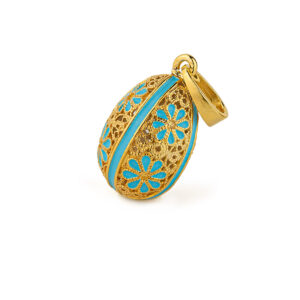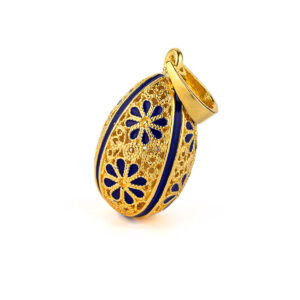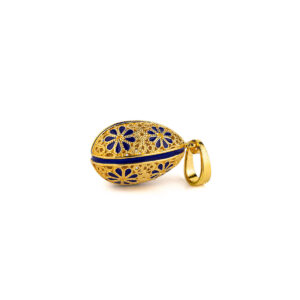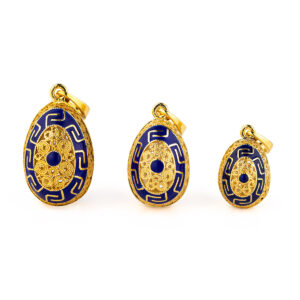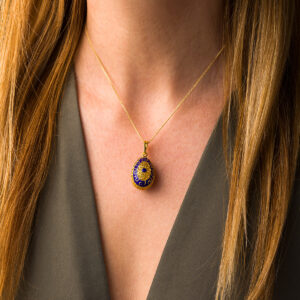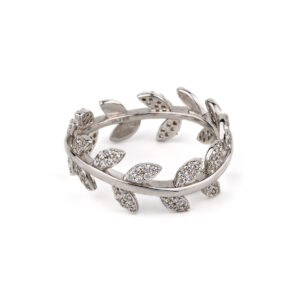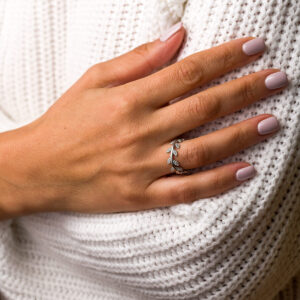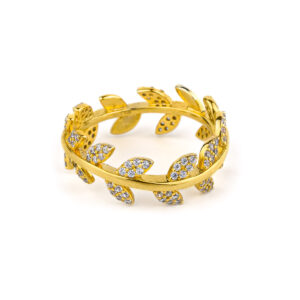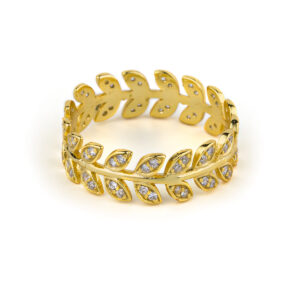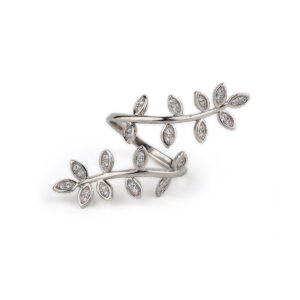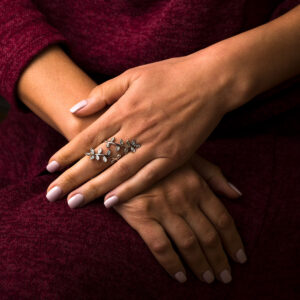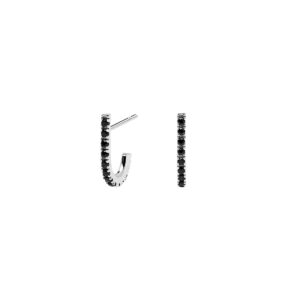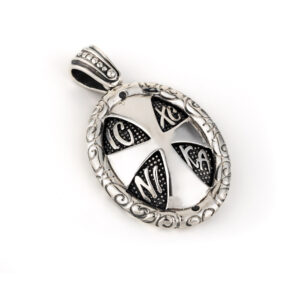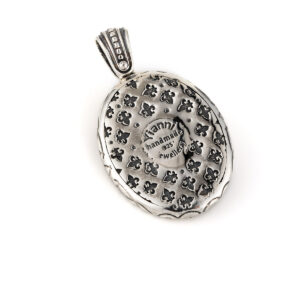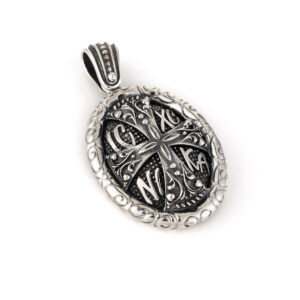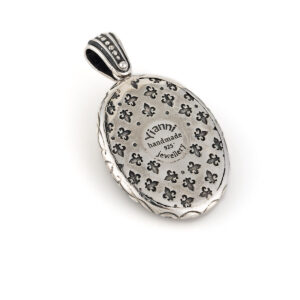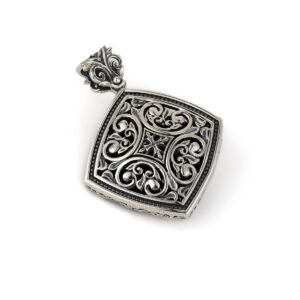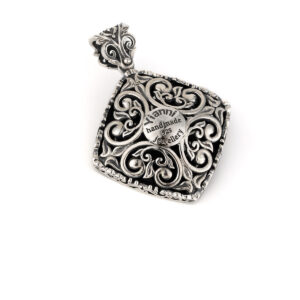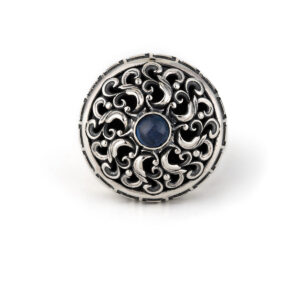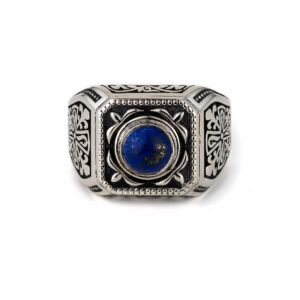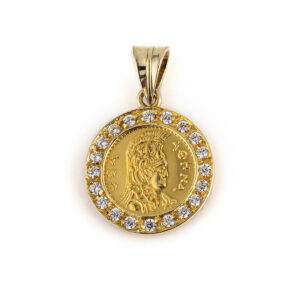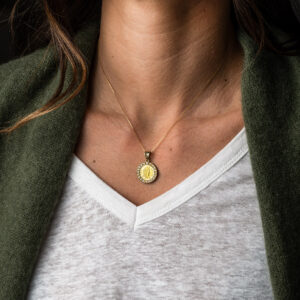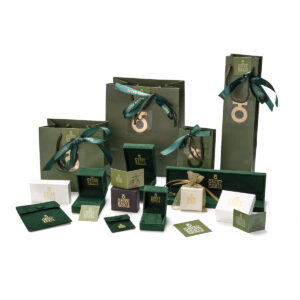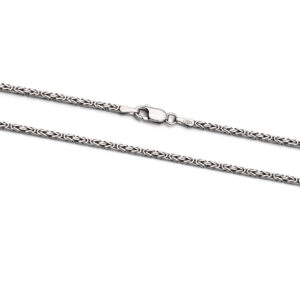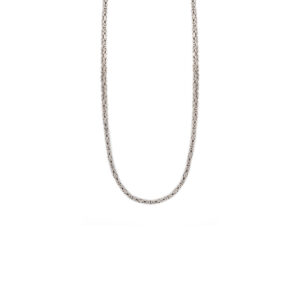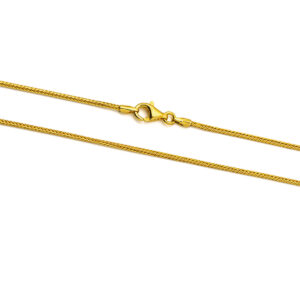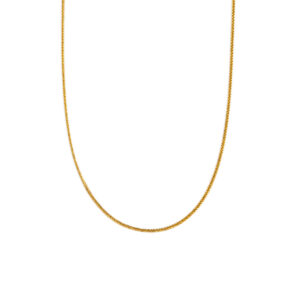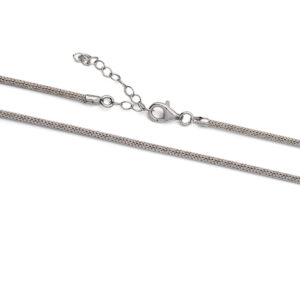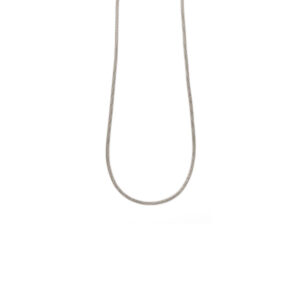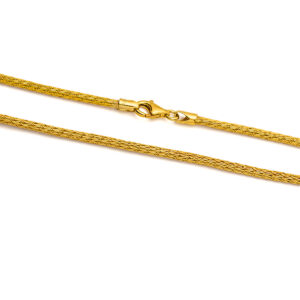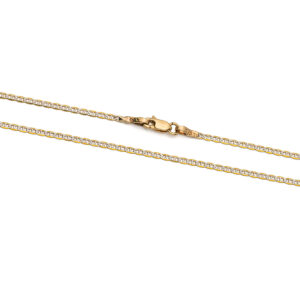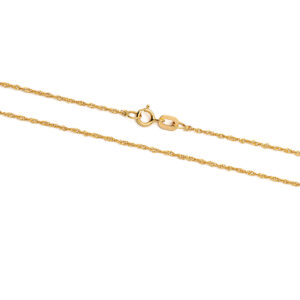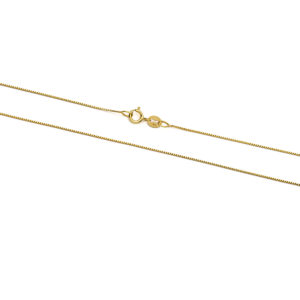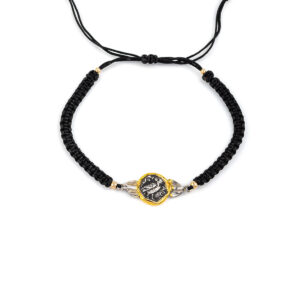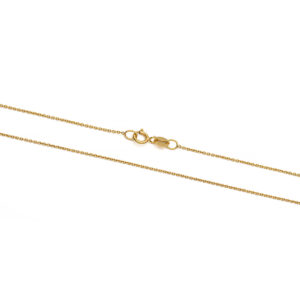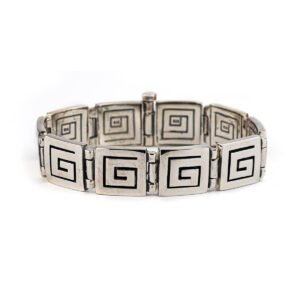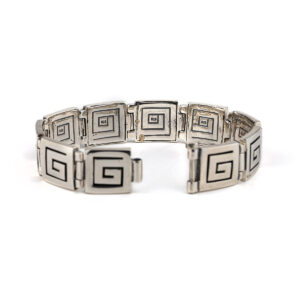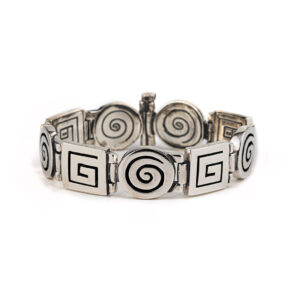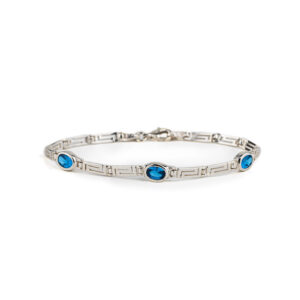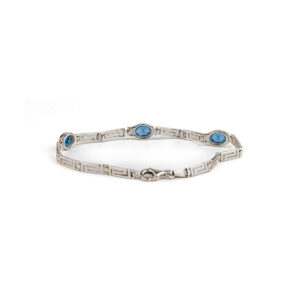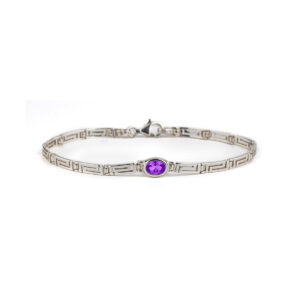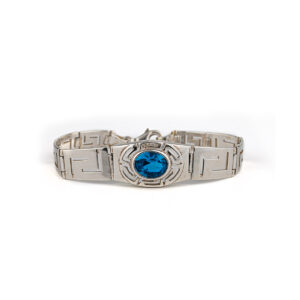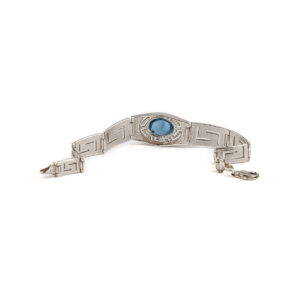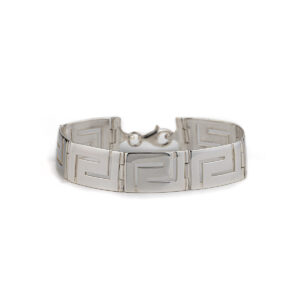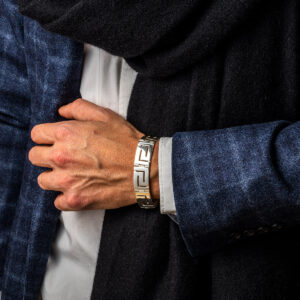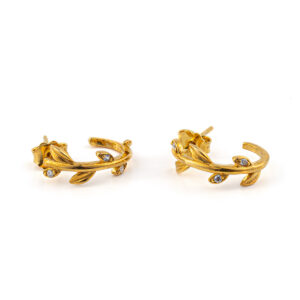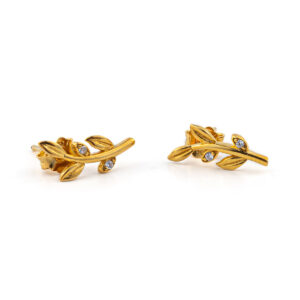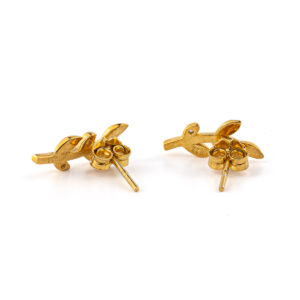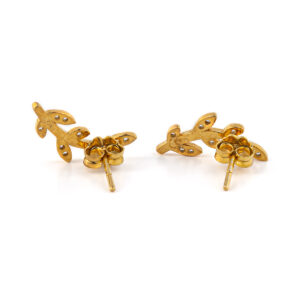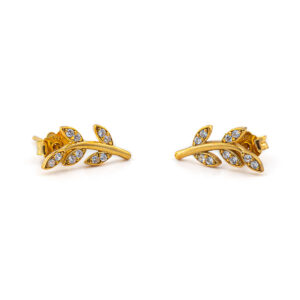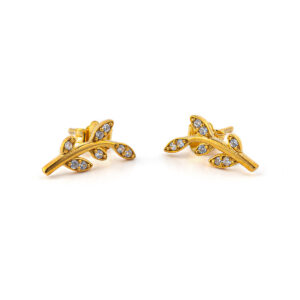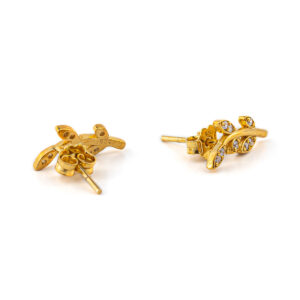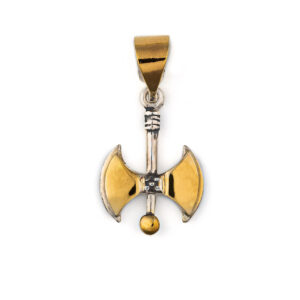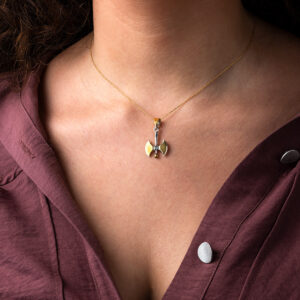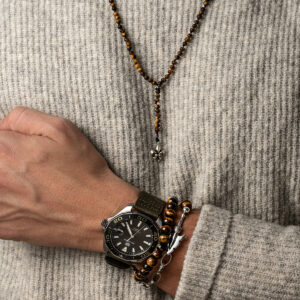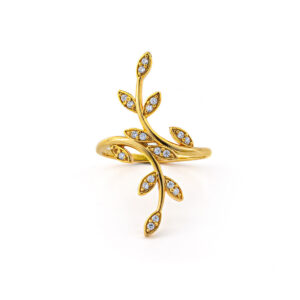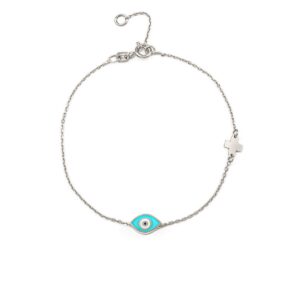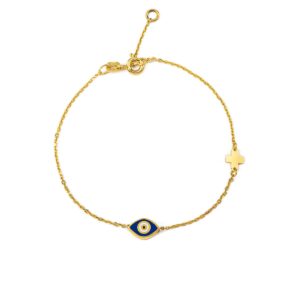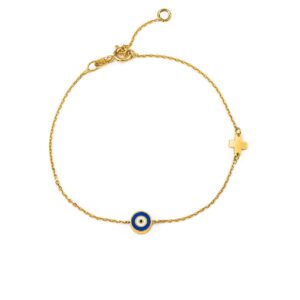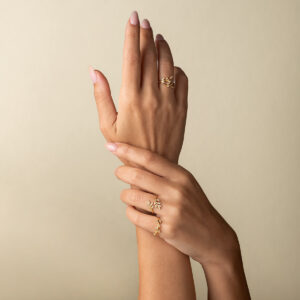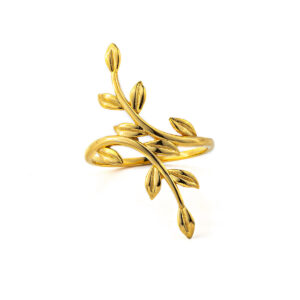Filigree Egg Turquoise Pendant Necklace with Flowers – Sterling Silver Gold Plated
The pendant is embellished with fine filigree and turquoise enamel in Faberge style.
Made of 925 sterling silver and gold plated.
The chain shown is included.
Filigree is a delicate kind of jewelry metalwork, made with tiny beads or twisted threads, or both in combination, soldered together or to the surface of an object of the same metal and arranged in artistic motifs. The art of filigree dates back to ancient history. The first of the found jewelry in this technique has been found in Mesopotamia and dates to thousands of years BC. In the ancient world and particularly in Asia Minor, this art grew at the highest level.
Fabergé egg is a jeweled egg created by the House of Fabergé, in St. Petersburg, Imperial Russia. Virtually all were manufactured under the supervision of Peter Carl Fabergé between 1885 and 1917,[citation needed] the most famous being the 50 “Imperial” eggs, 43 of which survive, made for the Russian Tsars Alexander III and Nicholas II as Easter gifts for their wives and mothers. The first Fabergé egg was crafted for Tsar Alexander III, who had decided to give his wife, Empress Maria Feodorovna, an Easter egg in 1885. Peter Carl Fabergé was a Russian jeweler best known for the famous Fabergé eggs made in the style of genuine Easter eggs, using precious metals and gemstones. He’s the founder of the famous jewelry legacy House of Fabergé. (Wikipedia)
Meander or Meandros design, one of the most historic symbols of the Greek World, also called Greek Key and symbolizes long life and eternity. The pattern with Meandro was used in antiquity to decorate the frieze of temples.
Filigree Egg Enamel Pendant Necklace with Flowers
The pendant is embellished with fine filigree and blue enamel in Faberge style.
Made of 925 sterling silver and gold plated.
The chain shown is included.
Explore Byzantine Collection
Filigree is a delicate kind of jewelry metalwork, made with tiny beads or twisted threads, or both in combination, soldered together or to the surface of an object of the same metal and arranged in artistic motifs. The art of filigree dates back to ancient history. The first of the found jewelry in this technique has been found in Mesopotamia and dates to thousands of years BC. In the ancient world and particularly in Asia Minor, this art grew at the highest level.
Fabergé egg is a jeweled egg created by the House of Fabergé, in St. Petersburg, Imperial Russia. Virtually all were manufactured under the supervision of Peter Carl Fabergé between 1885 and 1917,[citation needed] the most famous being the 50 “Imperial” eggs, 43 of which survive, made for the Russian Tsars Alexander III and Nicholas II as Easter gifts for their wives and mothers. The first Fabergé egg was crafted for Tsar Alexander III, who had decided to give his wife, Empress Maria Feodorovna, an Easter egg in 1885. Peter Carl Fabergé was a Russian jeweler best known for the famous Fabergé eggs made in the style of genuine Easter eggs, using precious metals and gemstones. He’s the founder of the famous jewelry legacy House of Fabergé. (Wikipedia)
Meander Filigree Egg Pendant Necklace with Blue Enamel – Sterling Silver Gold Plated
The pendant is embellished with fine filigree and blue enamel in Faberge style. Also, the pendant is decorated with a Meander design.
Made of 925 sterling silver and gold plated.
The chain shown is included.
Filigree is a delicate kind of jewelry metalwork, made with tiny beads or twisted threads, or both in combination, soldered together or to the surface of an object of the same metal and arranged in artistic motifs. The art of filigree dates back to ancient history. The first of the found jewelry in this technique has been found in Mesopotamia and dates to thousands of years BC. In the ancient world and particularly in Asia Minor, this art grew at the highest level.
Fabergé egg is a jeweled egg created by the House of Fabergé, in St. Petersburg, Imperial Russia. Virtually all were manufactured under the supervision of Peter Carl Fabergé between 1885 and 1917,[citation needed] the most famous being the 50 “Imperial” eggs, 43 of which survive, made for the Russian Tsars Alexander III and Nicholas II as Easter gifts for their wives and mothers. The first Fabergé egg was crafted for Tsar Alexander III, who had decided to give his wife, Empress Maria Feodorovna, an Easter egg in 1885. Peter Carl Fabergé was a Russian jeweler best known for the famous Fabergé eggs made in the style of genuine Easter eggs, using precious metals and gemstones. He’s the founder of the famous jewelry legacy House of Fabergé. (Wikipedia)
Meander or Meandros design, one of the most historic symbols of the Greek World, also called Greek Key and symbolizes long life and eternity. The pattern with Meandro was used in antiquity to decorate the frieze of temples.
Meander Filigree Egg Pendant Necklace with Turquoise Enamel – Sterling Silver Gold Plated
The pendant is embellished with fine filigree and turquoise enamel in Faberge style. Also, the pendant is decorated with a Meander design.
Made of 925 sterling silver and gold plated.
The chain shown is included.
Filigree is a delicate kind of jewelry metalwork, made with tiny beads or twisted threads, or both in combination, soldered together or to the surface of an object of the same metal and arranged in artistic motifs. The art of filigree dates back to ancient history. The first of the found jewelry in this technique has been found in Mesopotamia and dates to thousands of years BC. In the ancient world and particularly in Asia Minor, this art grew at the highest level.
Fabergé egg is a jeweled egg created by the House of Fabergé, in St. Petersburg, Imperial Russia. Virtually all were manufactured under the supervision of Peter Carl Fabergé between 1885 and 1917,[citation needed] the most famous being the 50 “Imperial” eggs, 43 of which survive, made for the Russian Tsars Alexander III and Nicholas II as Easter gifts for their wives and mothers. The first Fabergé egg was crafted for Tsar Alexander III, who had decided to give his wife, Empress Maria Feodorovna, an Easter egg in 1885. Peter Carl Fabergé was a Russian jeweler best known for the famous Fabergé eggs made in the style of genuine Easter eggs, using precious metals and gemstones. He’s the founder of the famous jewelry legacy House of Fabergé. (Wikipedia)
Meander or Meandros design, one of the most historic symbols of the Greek World, also called Greek Key and symbolizes long life and eternity. The pattern with Meandro was used in antiquity to decorate the frieze of temples.
Egg Pendant Necklace with Enamel – Sterling Silver Gold Plated
A beautifully crafted egg – shaped pendant, made of 925 sterling silver and gold plated with turquoise enamel.
Used as a charm or as a pendant.
Pick up a beautiful Easter gift!
The chain shown is included.
Olive Leaf Zircon Ring – 925 Sterling Silver
Ring inspired by the olive leaf symbol.
Made of 925 Sterling Silver.
The olive wreath also known as kotinos was the prize for the winner at the ancient Olympic Games. It was an olive branch, of the wild- olive tree that grew at Olympia, intertwined to form a circle or a horse-shoe. According to Pausanias it was introduced by Heracles as a prize for the running race winner to honour his father Zeus. In the ancient Olympic Games there were no gold, silver, or bronze medals. There was only one winner per event, crowned with an olive wreath made of wild-olive leaves from a sacred tree near the temple of Zeus at Olympia. Olive wreaths were given out during the 2004 Summer Olympics in Athens in honor of the ancient tradition, because the games were being held in Greece.
Olive Leaf Zircon Ring – 925 Sterling Silver and Gold Plated
Ring inspired by the olive leaf symbol.
Made of 925 Sterling Silver and Gold Plated
The olive wreath also known as kotinos was the prize for the winner at the ancient Olympic Games. It was an olive branch, of the wild- olive tree that grew at Olympia, intertwined to form a circle or a horse-shoe. According to Pausanias it was introduced by Heracles as a prize for the running race winner to honour his father Zeus. In the ancient Olympic Games there were no gold, silver, or bronze medals. There was only one winner per event, crowned with an olive wreath made of wild-olive leaves from a sacred tree near the temple of Zeus at Olympia. Olive wreaths were given out during the 2004 Summer Olympics in Athens in honor of the ancient tradition, because the games were being held in Greece.
Olive Leaves Ring – 925 Sterling Silver and Gold Plated
Ring inspired by the olive leaf symbol.
Made of 925 Sterling Silver and Gold Plated
The olive wreath also known as kotinos was the prize for the winner at the ancient Olympic Games. It was an olive branch, of the wild- olive tree that grew at Olympia,intertwined to form a circle or a horse-shoe. According to Pausanias it was introduced by Heracles as a prize for the running race winner to honour his father Zeus. In the ancient Olympic Games there were no gold, silver, or bronze medals. There was only one winner per event, crowned with an olive wreath made of wild olive leaves from a sacred tree near the temple of Zeus at Olympia. Olive wreaths were given out during the 2004 Summer Olympics in Athens in honor of the ancient tradition, because the games were being held in Greece.
Olive Leaf Branch Ring – 925 Sterling Silver
Ring inspired by the olive leaf symbol.
Made of 925 Sterling Silver.
The olive wreath also known as kotinos was the prize for the winner at the ancient Olympic Games. It was an olive branch, of the wild- olive tree that grew at Olympia,intertwined to form a circle or a horse-shoe. According to Pausanias it was introduced by Heracles as a prize for the running race winner to honour his father Zeus. In the ancient Olympic Games there were no gold, silver, or bronze medals. There was only one winner per event, crowned with an olive wreath made of wild-olive leaves from a sacred tree near the temple of Zeus at Olympia. Olive wreaths were given out during the 2004 Summer Olympics in Athens in honor of the ancient tradition, because the games were being held in Greece.
PD PAOLA BLACK BIRD EARRINGS – 925 STERLING SILVER
49,00€Unique Pd Paola earrings from the L’Essentiel collection, made of sterling silver, decorated with Zirconia. Making reference to the most important values of life, these designs are an intentional statement about essentiality: truth and beauty are found in the roots. 925 sterling silver dainty jewelry with black and white zirconia build a minimalist setting where the effortless elegance shines by itself.
IC XC NIKA Cross Pendant Sterling Silver – Yianni Jewelry
This is a beautiful cross pendant.
Τhe cross is placed in an oval frame on which the ”ICXC NIKA” is engraved. IC XC NI KA symbol: IC XC for “Jesus Christ” and NI KA for “conquered”. The Byzantine symbol is also known as “En Touto Nika”.
Pendant inspired by Byzantine designs.
Made of 925⁰ sterling silver
Handmade item.
Silver creations of Yianni Jewelry, created by Garbis Khacherian, a silversmith trader since 1987.
ICXC NIKA Cross Pendant Sterling Silver – Yianni Jewelry
This is a beautiful imposed cross pendant.
Τhe cross is placed in an oval frame on which the ”ICXC NIKA” is engraved. IC XC NI KA symbol: IC XC for “Jesus Christ” and NI KA for “conquered”. The Byzantine symbol is also known as “En Touto Nika”.
Pendant inspired by Byzantine designs.
Silver oxidized finish.
Made of 925⁰ sterling silver
Handmade item
Silver creations of Yianni Jewelry, created by Garbis Khacherian, a silversmith trader since 1987.
Cross Filigree Pendant Sterling Silver – Yianni Jewelry
Made of 925° sterling silver.
Handmade Item.
Silver creations of Yianni Jewelry, created by Garbis Khacherian, a silversmith trader since 1987.
Greek Meander Floral Lapis Ring – Sterling Silver Yianni Jewelry
Τhis is an impressive oxidized ring made of sterling silver 925 and decorated with a lapis lazuli gemstone at the center.
Ιts large round surface in the shape of a dome has embossed designs.
On the perimeter of the ring, there is the design of the Meander, the most ancient Greek symbol, which is considered to be the symbol of Victory and Eternal Life.
Embossed designs are also on the side of the ring.
Handmade item.
Silver creations of Yianni Jewelry, created by Garbis Khacherian, a silversmith trader since 1987.
Explore Yianni Jewellery
Lapis Cross Signet Ring – Sterling Silver Yianni Jewelry
Made of 925⁰ sterling silver
Silver creations of Yianni Jewelry, created by Garbis Khacherian, a silversmith trader since 1987.
Explore Yianni Jewellery
Goddess Athena and Owl Pendant with Crystals – 14K Solid Gold
835,00€This coin illustrates the portrait of Goddess Athena on the one side and the wisdom owl on the other.
Α beautiful and timeless coin pendant.
Made of 14k gold with crystals.
The chain shown is our 14K Gold Box Chain in Length 50cm (not included).
Goddess Athena and Owl – Athenian silver tetradrachm.
Dracma was the currency used in Greece during several periods in its history. The tetradrachm was an Ancient Greek silver coin equivalent to fourdrachmae in Athens it replaced the earlier “heraldic” type of didrachms and it was in wide circulation from ca. 510 to ca. 38 BC. This coin belongs to the so-called “new style Athenian coins” minted between 166 and 64 B.C. and is considered one of the most popular ancient Greek coins which illustrate the portrait of Goddess Athena on the one side and the wisdom owl on the other. Athena is an ancient Greek goddess associated with wisdom, handicraft, and warfare. Athena was regarded as the patron and protectress of various cities across Greece, particularly the city of Athens, from which she most likely received her name. She’s usually shown in art wearing a helmet and holding a spear. Her major symbols include owls, olive trees, and snakes. Her temples were located atop the fortified Acropolis in the central part of the city. The Parthenon on the Athenian Acropolis is dedicated to her, along with numerous other temples and monuments. Her main festival in Athens was the Panathenaia, which was celebrated in midsummer and was the most important festival on the Athenian calendar. In the classical Olympian pantheon, Athena was regarded as the favorite daughter of Zeus. The owl traditionally accompanies Athena. Because of such association, the owl has been used as a symbol of knowledge and wisdom. The inscriptions contain the city’s “national” appellation (“ΑΘΕ», i.e. “of the Athenians”). As in all handmade items, there may be small differences in weight and dimensions and this is what makes them unique and precious.
925 Sterling Silver Oxidised Wheat Chain
Made of 925 Sterling Silver.
Handmade item.
925 Sterling Silver Chain Necklace in Length 50cm
Made of 925 Sterling Silver.
Handmade item.
Wheat Chain – 925 Sterling Silver and Gold Plated
Made of 925 Sterling Silver and Gold Plated.
Handmade item.
925 Sterling Silver Chain Necklace in Length 45cm
Made of 925 Sterling Silver.
Handmade item.
925 Sterling Silver and Gold Plated Byzantine Chain 50cm
Made of 925 Sterling Silver and Gold Plated.
Handmade item.
925 Sterling Silver and Gold Plated Byzantine Chain 45cm
Made of 925 Sterling Silver and Gold Plated.
Handmade item.
14K Gold Twisted Chain
245,00€ – 265,00€Box Chain – 925 Sterling Silver and Gold Plated
Made of 925 Sterling Silver and Gold Plated.
Handmade item.
Goddess Athena Coin Macrame Bracelet – 14K Gold and 925 Sterling Silver
Α beautiful and elegant bracelet inspired by an ancient Greek tetradrachm.
Made in 14k gold and 925 sterling silver.
Handmade item.
Goddess Athena and Owl – Athenian silver tetradrachm
Dracma was the currency used in Greece during several periods in its history. The tetradrachm was an Ancient Greek silver coin equivalent to fourdrachmae in Athens it replaced the earlier “heraldic” type of didrachms and it was in wide circulation from ca. 510 to ca. 38 BC. This coin belongs to the so-called “new style Athenian coins” minted between 166 and 64 B.C. and is considered one of the most popular ancient Greek coins which illustrate the portrait of Goddess Athena on the one side and the wisdom owl on the other. Athena is an ancient Greek goddess associated with wisdom, handicraft, and warfare. Athena was regarded as the patron and protectress of various cities across Greece, particularly the city of Athens, from which she most likely received her name. She’s usually shown in art wearing a helmet and holding a spear. Her major symbols include owls, olive trees, and snakes. Her temples were located atop the fortified Acropolis in the central part of the city. The Parthenon on the Athenian Acropolis is dedicated to her, along with numerous other temples and monuments. Her main festival in Athens was the Panathenaia, which was celebrated in midsummer and was the most important festival on the Athenian calendar. In the classical Olympian pantheon, Athena was regarded as the favorite daughter of Zeus. The owl traditionally accompanies Athena. Because of such association, the owl has been used as a symbol of knowledge and wisdom. The inscriptions contain the city’s “national” appellation (“ΑΘΕ», i.e. “of the Athenians”).
Cable Chain in 14K Gold
152,00€ – 195,00€Greek Key Meander Link Bracelet – 925 Sterling Silver
Bracelet with Greek key motif.
Made of 925⁰ sterling silver.
Handmade item.
Greek Key Spiral Link Bracelet – 925 Sterling Silver
Bracelet with Greek key motif.
Made of 925⁰ sterling silver.
Handmade item.
Greek Key Link Bracelet with Blue Zircon – 925 Sterling Silver
Bracelet with Greek key.
Made of 925⁰ sterling silver with zircon.
Handmade item.
Greek Key Meander Zircon Bracelet – 925 Sterling Silver
Bracelet with Greek key motif.
Made of 925⁰ sterling silver with zircon.
Handmade item.
Greek Key Meander Bracelet with Zircon – 925 Sterling Silver
Bracelet with Greek key motif.
Made of 925⁰ sterling silver with zircon.
Handmade item.
Greek Key Link Bracelet – 925 Sterling Silver
Sterling Silver Bracelet with Greek key motif.
Handmade item.
Made in 925⁰ sterling silver.
Explore Meandros Collection
Meandros design is a decorative border constructed from a continuous line, shaped into a repeated motif. Such a design is also called the Greek fret or Greek key design, although these are modern designations. On the one hand, the name “meander” recalls the twisting and turning path of the Meander River in Asia Minor, and on the other hand, as Karl Kerenyi pointed out, “the meander is the figure of a labyrinth in linear form” the meaning is that there is no beginning and no end in some cases so it becomes the symbol of long life and eternity.
Olive Leaves Earrings with Zircon – 14K Solid Yellow Gold
620,00€Earrings inspired by the olive leaf symbol.
Made of 14k gold with zircon.
The olive wreath also known as kotinos was the prize for the winner at the ancient Olympic Games. It was an olive branch, of the wild- olive tree that grew at Olympia, intertwined to form a circle or a horse-shoe. According to Pausanias it was introduced by Heracles as a prize for the running race winner to honour his father Zeus. In the ancient Olympic Games there were no gold, silver, or bronze medals. There was only one winner per event, crowned with an olive wreath made of wild-olive leaves from a sacred tree near the temple of Zeus at Olympia. Olive wreaths were given out during the 2004 Summer Olympics in Athens in honor of the ancient tradition, because the games were being held in Greece.
Olive Leaf Earrings with Zircon – 14K Solid Yellow Gold
428,00€Earrings inspired by the olive leaf symbol.
Made of 14k gold with zircon.
The olive wreath also known as kotinos was the prize for the winner at the ancient Olympic Games. It was an olive branch, of the wild- olive tree that grew at Olympia,intertwined to form a circle or a horse-shoe. According to Pausanias it was introduced by Heracles as a prize for the running race winner to honour his father Zeus. In the ancient Olympic Games there were no gold, silver, or bronze medals. There was only one winner per event, crowned with an olive wreath made of wild-olive leaves from a sacred tree near the temple of Zeus at Olympia. Olive wreaths were given out during the 2004 Summer Olympics in Athens in honor of the ancient tradition, because the games were being held in Greece.
Olive Leaf Zircon Earrings – 14K Solid Yellow Gold
514,00€Earrings inspired by the olive leaf symbol.
Made of 14k gold with zircon.
The olive wreath also known as kotinos was the prize for the winner at the ancient Olympic Games. It was an olive branch, of the wild- olive tree that grew at Olympia,intertwined to form a circle or a horse-shoe. According to Pausanias it was introduced by Heracles as a prize for the running race winner to honour his father Zeus. In the ancient Olympic Games there were no gold, silver, or bronze medals. There was only one winner per event, crowned with an olive wreath made of wild-olive leaves from a sacred tree near the temple of Zeus at Olympia. Olive wreaths were given out during the 2004 Summer Olympics in Athens in honor of the ancient tradition, because the games were being held in Greece.
Leaf Zircon Earrings – 14K Solid Yellow Gold
568,00€Earrings inspired by the olive leaf symbol.
Made of 14k gold with zircon.
The olive wreath also known as kotinos was the prize for the winner at the ancient Olympic Games. It was an olive branch, of the wild- olive tree that grew at Olympia,intertwined to form a circle or a horse-shoe. According to Pausanias it was introduced by Heracles as a prize for the running race winner to honour his father Zeus. In the ancient Olympic Games there were no gold, silver, or bronze medals. There was only one winner per event, crowned with an olive wreath made of wild-olive leaves from a sacred tree near the temple of Zeus at Olympia. Olive wreaths were given out during the 2004 Summer Olympics in Athens in honor of the ancient tradition, because the games were being held in Greece.
Leaf Earrings with Zircon – 14K Solid Yellow Gold
428,00€Earrings inspired by the olive leaf symbol.
Made of 14k gold with zircon.
The olive wreath also known as kotinos was the prize for the winner at the ancient Olympic Games. It was an olive branch, of the wild- olive tree that grew at Olympia,intertwined to form a circle or a horse-shoe. According to Pausanias it was introduced by Heracles as a prize for the running race winner to honour his father Zeus. In the ancient Olympic Games there were no gold, silver, or bronze medals. There was only one winner per event, crowned with an olive wreath made of wild-olive leaves from a sacred tree near the temple of Zeus at Olympia. Olive wreaths were given out during the 2004 Summer Olympics in Athens in honor of the ancient tradition, because the games were being held in Greece.
Minoan Double Axe Pendant – 14K Yellow Gold and Sterling Silver
Pendant inspired by the Minoan double axe, known as labrys.
Made of 14K Gold and Sterling Silver
Handmade in Greece.
The chain shown is included.
Explore Heritage Collection
History
Labrys is, according to Plutarch, Minoan word for the double headed axe called in Greek πέλεκυς (pélekus). In ancient Crete, the double axe was an important sacred symbol of the Minoan religion. In Crete it never accompanies male gods, but always female goddesses. It seems that it associated with the worship of Mother Earth or Great Goddess.
Fleurs De Lis Rosary Necklace with Tiger Eye Beads – 925 Sterling Silver
Sterling Silver Fleurs de lis on Hand Crafted rosary with tiger eye beads.
Made of 925 sterling silver.
The Fleur-de-lis, is a stylized lily (in French, Fleur and lis mean ‘flower’ and ‘lily’ respectively) that is used as a decorative design or symbol. The Fleur-de-lis is particularly associated with France, notably during its monarchical period. As France is a historically Catholic nation, the Fleur-de-lis became at one, religious, political, dynastic, artistic, and emblematic symbol.
Olive Leaf Ring with Zircon – 14K Solid Yellow Gold
582,00€Ring inspired by the olive leaf symbol.
Made of 14k gold with zircon.
The olive wreath also known as kotinos was the prize for the winner at the ancient Olympic Games. It was an olive branch, of the wild- olive tree that grew at Olympia, intertwined to form a circle or a horse-shoe. According to Pausanias it was introduced by Heracles as a prize for the running race winner to honour his father Zeus. In the ancient Olympic Games there were no gold, silver, or bronze medals. There was only one winner per event, crowned with an olive wreath made of wild-olive leaves from a sacred tree near the temple of Zeus at Olympia. Olive wreaths were given out during the 2004 Summer Olympics in Athens in honor of the ancient tradition because the games were being held in Greece.
Evil Eye Turquoise Enamel Bracelet with Cross – 925 Sterling Silver
Evil eye bracelet with enamel.
Made of 925 sterling silver.
Evil Eye
The symbol and superstition of the evil eye is one of the strongest symbolic images in the world. The earliest known evidence for belief in the evil eye goes back to ancient Greece and Rome. It is suppose to wear off evil to anyone who wears it and various cultures believe in that, however in Greece it’s blue because at that time blue eyes were not so common and were thought to give the evil eye, so the blue is like a mirror to them. Nowadays it’s widely known and has became a trend.
Evil Eye Blue Enamel Bracelet with Cross – Sterling Silver and Gold Plated
Evil eye bracelet with enamel.
Made of 925 sterling silver and gold plated
Evil Eye
The symbol and superstition of the evil eye is one of the strongest symbolic images in the world. The earliest known evidence for belief in the evil eye goes back to ancient Greece and Rome. It is suppose to wear off evil to anyone who wears it and various cultures believe in that, however in Greece it’s blue because at that time blue eyes were not so common and were thought to give the evil eye, so the blue is like a mirror to them. Nowadays it’s widely known and has became a trend.
Round Enamel Evil Eye Bracelet with Cross – Sterling Silver and Plated
Evil eye bracelet with blue enamel.
Made of 925 sterling silver and gold plated.
Evil Eye
The symbol and superstition of the evil eye is one of the strongest symbolic images in the world. The earliest known evidence for belief in the evil eye goes back to ancient Greece and Rome. It is supposed to wear off evil to anyone who wears it and various cultures believe in that, however in Greece it’s blue because at that time blue eyes were not so common and were thought to give the evil eye, so the blue is like a mirror to them. Nowadays it’s widely known and has become a trend.
Leaf Adjustable Ring with Zircon – 14K Solid Yellow Gold
528,00€Ring inspired by the olive leaf symbol.
Made of 14k gold with zircon.
The olive wreath also known as kotinos was the prize for the winner at the ancient Olympic Games. It was an olive branch, of the wild- olive tree that grew at Olympia, intertwined to form a circle or a horse-shoe. According to Pausanias it was introduced by Heracles as a prize for the running race winner to honour his father Zeus. In the ancient Olympic Games there were no gold, silver, or bronze medals. There was only one winner per event, crowned with an olive wreath made of wild-olive leaves from a sacred tree near the temple of Zeus at Olympia. Olive wreaths were given out during the 2004 Summer Olympics in Athens in honor of the ancient tradition, because the games were being held in Greece.
Olive Leaf Branch Ring – 18K Solid Yellow Gold
756,00€Ring inspired by the olive leaf symbol.
Made of 18k gold.
The olive wreath also known as kotinos was the prize for the winner at the ancient Olympic Games. It was an olive branch, of the wild- olive tree that grew at Olympia, intertwined to form a circle or a horse-shoe. According to Pausanias it was introduced by Heracles as a prize for the running race winner to honour his father Zeus. In the ancient Olympic Games there were no gold, silver, or bronze medals. There was only one winner per event, crowned with an olive wreath made of wild-olive leaves from a sacred tree near the temple of Zeus at Olympia. Olive wreaths were given out during the 2004 Summer Olympics in Athens in honor of the ancient tradition, because the games were being held in Greece.
Olive Leaf Branch Ring – 14K Solid Yellow Gold
560,00€Ring inspired by the olive leaf symbol.
Made of 14k gold.
The olive wreath also known as kotinos was the prize for the winner at the ancient Olympic Games. It was an olive branch, of the wild- olive tree that grew at Olympia, intertwined to form a circle or a horse-shoe. According to Pausanias it was introduced by Heracles as a prize for the running race winner to honour his father Zeus. In the ancient Olympic Games there were no gold, silver, or bronze medals. There was only one winner per event, crowned with an olive wreath made of wild-olive leaves from a sacred tree near the temple of Zeus at Olympia. Olive wreaths were given out during the 2004 Summer Olympics in Athens in honor of the ancient tradition because the games were being held in Greece.
